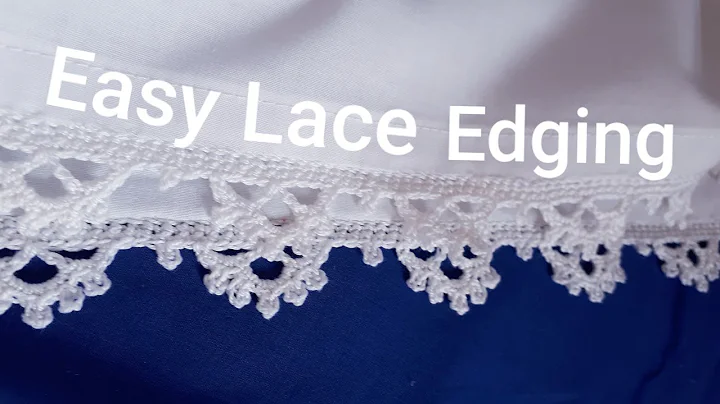Flattering Crochet Batwing Sweater for All Body Types
Table of Contents:
- Introduction
- Materials Needed
- Gauge and Sizing
- Pattern Breakdown
4.1 Foundation Row
4.2 Two-Row Pattern Repeat
4.3 Increasing Rows
4.4 Even Rows
- Changing Colors
- Sewing the Panels Together
- Creating the Arms
- Finishing Touches
- Conclusion
Introduction:
Welcome, crochet enthusiasts! If you're in search of a beginner-friendly crochet sweater pattern, you've come to the right place. In this article, I, Little John Yarns, will guide you through the process of creating a beautiful batwing sweater. Whether you're new to crochet or an experienced crafter, this pattern will help you create a stylish and comfortable sweater. So grab your crochet hook and let's get started!
Materials Needed:
Before we begin, let's gather all the materials you'll need for this project. The following items are required:
- 1300 to 1500 yards of yarn
- 6mm crochet hook
- Stitch markers
- Yarn needle
Gauge and Sizing:
To ensure that your sweater fits perfectly, it's crucial to obtain the correct gauge. The gauge for this pattern is as follows: 3 pattern rows equal 2 inches and 7 stitches across equal 2 inches. Make sure to check your gauge before you start. If your gauge isn't correct, your sweater won't fit properly. Remember to take note of the yarn fibers you're using, as different worsted weight yarns have different densities and stretch.
Pattern Breakdown:
Now, let's break down the pattern into easy-to-follow steps.
-
Foundation Row:
- Start by creating a foundation chain according to your size.
- Double crochet in the fourth chain from the hook and in each stitch across.
-
Two-Row Pattern Repeat:
- Chain four (counts as a double crochet and a chain one).
- Double crochet back into the same stitch, chain one, and skip the next stitch.
- Repeat the pattern sequence of skipping one stitch, double crocheting into the next, and chaining one across the row.
- Place two double crochets in the last stitch.
- Repeat the two-row pattern until you reach the required number of rows.
-
Increasing Rows:
- Continue increasing on both ends of each row, following the two-row pattern repeat.
-
Even Rows:
- Work an additional 12 rows using the same pattern as the last row.
- Change colors after every two rows, if desired, to create a beautiful rainbow effect.
Changing Colors:
To add a pop of color to your sweater, you can change colors after every two rows. This will create a stunning rainbow pattern. Simply fasten off your work at the end of the row, attach a new color yarn, and continue with the pattern.
Sewing the Panels Together:
Once you have completed both panels, it's time to sew them together. Place the panels side by side and slip stitch along the top, leaving the centermost stitches open for the neck. Repeat the same process for the bottom portion to create the armholes.
Creating the Arms:
To complete the sweater, leave the top 12 rows unworked and sew the remaining rows together to form the sleeves. You can use either the slip stitch technique or the mattress stitch to sew the pieces together.
Finishing Touches:
Once you have sewn the panels together and created the arms, your sweater is almost ready! Weave in any loose ends and give your sweater a gentle block to ensure it retains its shape. Now you can proudly wear your handmade batwing sweater, knowing that you created it yourself!
Conclusion:
Congratulations on completing your first batwing sweater! I hope you enjoyed following along with this pattern and found the steps easy to follow. Crocheting your own clothing is a rewarding experience, and I'm sure you'll love wearing your cozy and stylish creation. Don't forget to share your finished sweater with us and stay tuned for more crochet patterns and tutorials. Happy crocheting!
FAQs:
Q: Can I adjust the sizing of the sweater?
A: Yes, you can adjust the sizing by modifying the number of stitches in the foundation chain and the total number of rows. The pattern provides instructions for multiple sizes, but feel free to make further adjustments based on your preferences.
Q: Can I use a different yarn weight for this pattern?
A: It's best to use the recommended yarn weight (worsted) for this pattern to ensure the desired fit and drape. However, you can experiment with different yarn weights, keeping in mind that it may affect the size and overall appearance of the sweater.
Q: Can I make this sweater without the batwing sleeves?
A: Absolutely! If you prefer a more traditional style, you can modify the pattern by omitting the increases for the batwing sleeves. This will result in a regular fitted sweater with standard sleeves.
Q: Is this pattern suitable for beginners?
A: Yes, this pattern is beginner-friendly. It uses basic crochet stitches and provides step-by-step instructions. However, some prior knowledge of crochet techniques is recommended.
Q: Can I sell the finished sweaters made from this pattern?
A: Yes, you are allowed to sell the sweaters you make from this pattern. However, please give credit to the original pattern designer (Little John Yarns) when selling or sharing your finished products.
Q: Are there any video tutorials available for this pattern?
A: Yes, video tutorials for this pattern are available on my website. You can find the link in the description box below the article. These tutorials will provide visual guidance and make it even easier to follow along with the pattern.
 WHY YOU SHOULD CHOOSE BEAUTYBADY
WHY YOU SHOULD CHOOSE BEAUTYBADY







